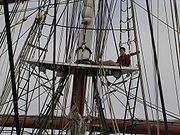.gif)
Top (sailing ship)
Encyclopedia

Crow's nest
A crow's nest is a structure in the upper part of the mainmast of a ship or structure, that is used as a lookout point.This position ensured the best view of the approaching hazards, other ships or land. It was the best device for this purpose until the invention of radar.In early ships it was...
" of the popular imagination – above the mainmast (for example) is the main-topmast, main-topgallant-mast and main-royal-mast, so that the top is actually about 1/4 to 1/3 of the way up the mast as a whole.

Futtock shrouds
Futtock shrouds are rope, wire or chain links in the rigging of a traditional square rigged ship. They run from the outer edges of a top downwards and inwards to a point on the mast or lower shrouds, and carry the load of the shrouds that rise from the edge of the top...
carry the load of the upper shrouds into the mast below.
At the upper end of the topmast and topgallant, there is a similar situation regarding the next mast up (topgallant and royal respectively). At these points a smaller top might be constructed, but it is more usual simply to leave the shroud-bearing struts open, in which case they are known as crosstrees
Crosstrees
Crosstrees are the two horizontal struts at the upper ends of the topmasts of sailboats, used to anchor the shrouds from the topgallant mast. Similarly, they may be mounted at the upper end of the topgallant to anchor the shrouds from the royal mast .See tops for the description of their purpose....
.
Access for sailors to the top may be by a Jacob's ladder
Jacob's ladder (nautical)
The term Jacob's ladder applies to a kind of ladder found on some square rigged ships. To climb above the lower mast to the topmast and above, sailors must get around the top, a platform projecting from the mast. Although on many ships the only way round was the overhanging futtock shrouds,...
, lubber's hole, or the futtock shrouds
Futtock shrouds
Futtock shrouds are rope, wire or chain links in the rigging of a traditional square rigged ship. They run from the outer edges of a top downwards and inwards to a point on the mast or lower shrouds, and carry the load of the shrouds that rise from the edge of the top...
– see the latter entry for more details.
Fighting top
A fighting top was an enlarged top with small gunsNaval artillery in the Age of Sail
Naval artillery in the Age of Sail encompasses the period of roughly 1571-1863: when large, sail-powered wooden naval warships dominated the high seas, mounting a bewildering variety of different types and sizes of cannon as their main armament. By modern standards, these cannon were extremely...
, designed to fire down at the deck of enemy ships. They could also be manned by sniper
Sniper
A sniper is a marksman who shoots targets from concealed positions or distances exceeding the capabilities of regular personnel. Snipers typically have specialized training and distinct high-precision rifles....
s armed with musket
Musket
A musket is a muzzle-loaded, smooth bore long gun, fired from the shoulder. Muskets were designed for use by infantry. A soldier armed with a musket had the designation musketman or musketeer....
s or rifle
Rifle
A rifle is a firearm designed to be fired from the shoulder, with a barrel that has a helical groove or pattern of grooves cut into the barrel walls. The raised areas of the rifling are called "lands," which make contact with the projectile , imparting spin around an axis corresponding to the...
s; Horatio Nelson was killed at the Battle of Trafalgar
Battle of Trafalgar
The Battle of Trafalgar was a sea battle fought between the British Royal Navy and the combined fleets of the French Navy and Spanish Navy, during the War of the Third Coalition of the Napoleonic Wars ....
by a sniper firing from a fighting top of the Redoutable
French ship Redoutable (1791)
The Redoutable was a Téméraire class 74-gun ship of the line of the French Navy. She is known for her duel with HMS Victory during the Battle of Trafalgar and for killing Vice Admiral Horatio Nelson during the action.- Early career :...
.

